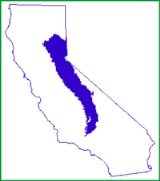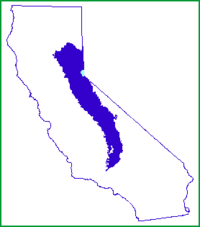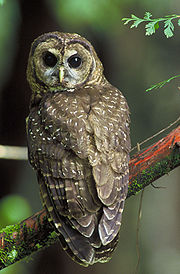
Sierra Nevada Logging
Encyclopedia

Logging
Logging is the cutting, skidding, on-site processing, and loading of trees or logs onto trucks.In forestry, the term logging is sometimes used in a narrow sense concerning the logistics of moving wood from the stump to somewhere outside the forest, usually a sawmill or a lumber yard...
in the California
California
California is a state located on the West Coast of the United States. It is by far the most populous U.S. state, and the third-largest by land area...
n Sierra Nevada arose from the need to support growing communities in the area. The Gold Rush
The Gold Rush
The Gold Rush is a 1925 silent film comedy written, produced, directed by, and starring Charlie Chaplin in his Little Tramp role. The film also stars Georgia Hale, Mack Swain, Tom Murray, Henry Bergman, Malcolm Waite....
created a high demand for timber
Timber
Timber may refer to:* Timber, a term common in the United Kingdom and Australia for wood materials * Timber, Oregon, an unincorporated community in the U.S...
to build housing, for mining
Mining
Mining is the extraction of valuable minerals or other geological materials from the earth, from an ore body, vein or seam. The term also includes the removal of soil. Materials recovered by mining include base metals, precious metals, iron, uranium, coal, diamonds, limestone, oil shale, rock...
procedures, and especially to build railroads
Rail transport
Rail transport is a means of conveyance of passengers and goods by way of wheeled vehicles running on rail tracks. In contrast to road transport, where vehicles merely run on a prepared surface, rail vehicles are also directionally guided by the tracks they run on...
. In these days use was unregulated and in the first 20 years after the rush, a third of the timber in the Sierra Nevada was logged . Concern for the forests created a movement towards conservation
Conservation ethic
Conservation is an ethic of resource use, allocation, and protection. Its primary focus is upon maintaining the health of the natural world: its, fisheries, habitats, and biological diversity. Secondary focus is on materials conservation and energy conservation, which are seen as important to...
at the turn of the 19th century creating state and national parks (Yosemite, Sequoia and Grant Grove) and forest reserves. The Sierra Club, a non-governmental organization
Non-governmental organization
A non-governmental organization is a legally constituted organization created by natural or legal persons that operates independently from any government. The term originated from the United Nations , and is normally used to refer to organizations that do not form part of the government and are...
(NGO), was founded around this time by the famous preservationist John Muir
John Muir
John Muir was a Scottish-born American naturalist, author, and early advocate of preservation of wilderness in the United States. His letters, essays, and books telling of his adventures in nature, especially in the Sierra Nevada mountains of California, have been read by millions...
. Between 1900 and 1940 agencies like the U.S. Forest Service and The National Park Service
National Park Service
The National Park Service is the U.S. federal agency that manages all national parks, many national monuments, and other conservation and historical properties with various title designations...
regulated the use of the Sierra Nevada’s resources. The economy boom after World War II
World War II
World War II, or the Second World War , was a global conflict lasting from 1939 to 1945, involving most of the world's nations—including all of the great powers—eventually forming two opposing military alliances: the Allies and the Axis...
dramatically increased timber production in the Sierras using clear-cutting as the dominant form of logging.
Methods
One method of logging is clear-cutting, removing all trees from a tract of land, which has caused major disturbances in the Sierra Nevada environment leaving patches of densely packed, single-specie, same-aged, tree plantations among the diverse old growth forestOld growth forest
An old-growth forest is a forest that has attained great age , and thereby exhibits unique ecological features. An old growth forest has also usually reached a climax community...
. Low-impact logging meets current needs without compromising the ability of future generations to meet their needs. This typically means smaller periodic harvests and removing the worst trees to eliminate danger to high value trees. Forest management
Forest management
200px|thumb|right|[[Sustainable development|Sustainable]] forest management carried out by [[Complejo Forestal y Maderero Panguipulli|Complejo Panguipulli]] has contributed to the preservation of the forested landscape around [[Neltume]], a sawmill town in Chile...
, concerning harvest rate, reforestation
Reforestation
Reforestation is the natural or intentional restocking of existing forests and woodlands that have been depleted, usually through deforestation....
, erosion control
Erosion control
Erosion control is the practice of preventing or controlling wind or water erosion in agriculture, land development and construction. Effective erosion controls are important techniques in preventing water pollution and soil loss.-Introduction:...
, and stream protection, is key to limiting environmental degradation from timber harvesting and to protect future resources
Logging industry
Although very significant in certain local economies, the overall economic impact of the forest industry in California in the 21st century is fairly modest. The total timber harvest in 2000 was some 2.0 billion board feetBoard foot
The board-foot is a specialized unit of measure for the volume of lumber in the United States and Canada. It is the volume of a one-foot length of a board one foot wide and one inch thick....
of wood, with a harvest value of $909 million. Sierra Pacific Industries, based in Redding, California
Redding, California
Redding is a city in far-Northern California. It is the county seat of Shasta County, California, USA. With a population of 89,861, according to the 2010 Census...
, owns and manages roughly 1.4 million acres (5,700 km²) of forestland in California, making it the largest private forest owner in the state.
Environmental effects

Habitat fragmentation
Habitat fragmentation as the name implies, describes the emergence of discontinuities in an organism's preferred environment , causing population fragmentation...
and increased edge effect
Edge effect
The edge effect in ecology is the effect of the juxtaposition or placing side by side of contrasting environments on an ecosystem.This term is commonly used in conjunction with the boundary between natural habitats, especially forests, and disturbed or developed land. Edge effects are especially...
, along with releasing pesticides and chemicals into the water and land. In the Sierra’s there are 218 endemic plant species that are considered rare or threatened, and three plant species are believed to be extinct. Sixty-nine terrestrial vertebrate species are considered at risk by government agencies. A famous North American endangered species, the California Spotted Owl
Spotted Owl
The Spotted Owl, Strix occidentalis, is a species of true owl. It is a resident species of forests in western North America, where it nests in tree holes, old bird of prey nests, or rock crevices. Nests can be between 13 and 66 yards high and usually contain two eggs...
, depends on large tracts of old-growth coniferous forests and its protection has been a major wildlife and forest management issue.

